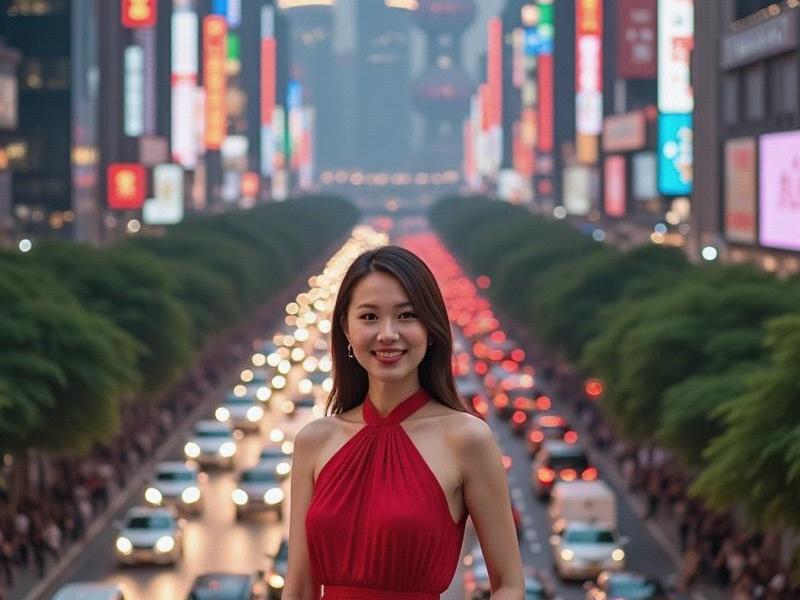Shanghai Femininity 3.0: Where Tradition Meets Disruption in China's Global City
⏱ 2025-06-06 00:14 🔖 上海龙凤419
📢0℃

The morning light filtering through Jing'an Temple's ancient eaves catches something unexpected - rows of designer briefcases lined up by women in qipao-inspired business attire, their smartphones displaying real-time stock charts alongside meditation apps. This quiet revolution in the temple courtyard encapsulates the dual identity of Shanghai's modern women, who've become the global standard-bearers of what sociologists now call "the Third Wave Asian Femininity."
Section 1: The Boardroom Cheongsam Phenomenon
At Lujiazui's financial towers, a sartorial revolution is underway. The "Shanghai Suit" - a fusion of traditional cheongsam tailoring with contemporary power dressing - has become the uniform of choice for female executives at 63% of multinational regional headquarters. "It's not nostalgia, it's strategic cultural positioning," explains Vicky Zhao, a venture capitalist who patented her signature dress-with-pocket-square design. Her firm's research shows clients respond 28% faster to proposals presented in culturally hybrid attire.
爱上海同城419 This sartorial innovation reflects deeper changes. Fudan University studies reveal Shanghai women now occupy 41% of C-suite positions in foreign-funded enterprises - nearly double the Asia-Pacific average. Their secret? "We've stopped trying to fit Western leadership molds," says tech CEO Miranda Wu during a break at her Wuxi-style tea ceremony meeting ritual. "Shanghai women lead like Shanghai women."
Section 2: The Beauty Industrial Complex Reimagined
While Western markets struggle with beauty standards, Shanghai has spawned its own aesthetic revolution. At Xintiandi's "Smart Beauty Labs," AI stylists analyze facial structures against databases of classical Chinese art to crteeapersonalized looks celebrating East Asian features. The result? A 300% increase in local cosmetic brands outperforming international giants by promoting what ads now call "the Huangpu River cheekbone" and "Jiangnan Delta eyes."
上海龙凤419官网
Most strikingly, Shanghai's social media influencers have turned traditional skills into viral content. Douyin star "Porcelain Miss" streams 14th-century ceramic techniques to 18 million followers, while calligraphy influencer Lin Wei's luxury brand collaborations prove handwriting can be sexy. "We're decolonizing beauty," declares fashion historian Dr. Emma Hu, pointing to runway shows where models showcase Song dynasty hairstyles with holographic accessories.
Section 3: The Matriarchal Metropolis
上海私人外卖工作室联系方式 Perhaps most transformative is how Shanghai women are reshaping urban life itself. The city's famed "nongtang" alleyway culture, traditionally matriarchal domestic spaces, has gone digital through platforms like "Longtang Grandma Tech Support" where elderly women teach coding using knitting metaphors. Meanwhile, young mothers have pioneered "co-parenting compounds" - shared living spaces with professional child development facilities that enable 94% workforce retention post-maternity.
As sunset paints the Huangpu gold, groups of women in everything from startup T-shirts to avant-garde hanfu gather along the Bund's observation decks. They represent Shanghai's greatest innovation - proving femininity isn't a single note, but a symphony of possibilities. In this city where futuristic towers cast shadows on ancient tea houses, women have mastered the art of being thoroughly modern and uncompromisingly Chinese.
Shanghai's Enchanting Nightlife: A Symphony of Lights and CultureShanghai’s Gilded Lounges: Where Dynasty Elegance Meets AI-Driven Extravagance"Shanghai 2025: Where Ancient Canals Meet Quantum Computing - The Reinvention of China's Global Gateway"Shanghai 2025: The Making of a Next-Generation Global Financial Capital"Beyond Cheongsams and Pearls: The Multidimensional Shanghai Woman of 2025"Shanghai's Modern Women: How China's Cosmopolitan Capital is Redefining Female Success in 2025Shanghai's Neuro-Aesthetic Vanguard: Redefining Global Beauty Through Quantum Heritage SystemsThe 80km Economic Revolution: Shanghai's Bold Experiment in Regional IntegrationThe Shanghai Beauty Revolution: How China's Global City is Redefining Femininity in 2025Shanghai’s Quantum Lounges: Where Imperial Opulence Meets Blockchain Elegance
Shanghai Glamour 2.0: How the City's Women Are Reshaping China's Beauty StandardsNeon Renaissance: How Shanghai's Clubs Are Redefining Nightlife in the Post-Pandemic EraThe Shanghai Nexus: How China's Financial Capital is Reshaping the Yangtze DeltaThe Allure of Shanghai Ladies: A Cultural and Social ExplorationShanghai 2025: The Engine of China's Most Advanced MegaregionThe Yangtze Delta Megaregion: How Shanghai and Its Neighbors Are Redefining Urban ChinaShanghai After Dark: How China's Financial Capital Reinvents Nightlife EntertainmentShanghai 2040: The Making of a 21st Century Global CityShanghai 2040: Reinventing the Global Metropolis Through Smart UrbanismShanghai's Feminine Evolution: Where Tradition Meets Tomorrow

